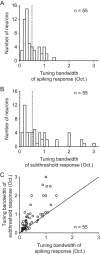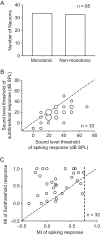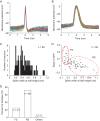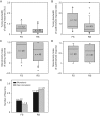Subthreshold Activity Underlying the Diversity and Selectivity of the Primary Auditory Cortex Studied by Intracellular Recordings in Awake Marmosets
- PMID: 29377991
- PMCID: PMC6373684
- DOI: 10.1093/cercor/bhy006
Subthreshold Activity Underlying the Diversity and Selectivity of the Primary Auditory Cortex Studied by Intracellular Recordings in Awake Marmosets
Abstract
Extracellular recording studies have revealed diverse and selective neural responses in the primary auditory cortex (A1) of awake animals. However, we have limited knowledge on subthreshold events that give rise to these responses, especially in non-human primates, as intracellular recordings in awake animals pose substantial technical challenges. We developed a novel intracellular recording technique in awake marmosets to systematically study subthreshold activity of A1 neurons that underlies their diverse and selective spiking responses. Our findings showed that in contrast to predominantly transient depolarization observed in A1 of anesthetized animals, both transient and sustained depolarization (during or beyond the stimulus period) were observed. Comparing with spiking responses, subthreshold responses were often longer lasting in duration and more broadly tuned in frequency, and showed narrower intensity tuning in non-monotonic neurons and lower response threshold in monotonic neurons. These observations demonstrated the enhancement of stimulus selectivity from subthreshold to spiking responses in individual A1 neurons. Furthermore, A1 neurons classified as regular- or fast-spiking subpopulation based on their spike shapes exhibited distinct response properties in frequency and intensity domains. These findings provide valuable insights into cortical integration and transformation of auditory information at the cellular level in auditory cortex of awake non-human primates.
Figures






References
-
- Bendor D, Wang X. 2007. Differential neural coding of acoustic flutter within primate auditory cortex. Nat Neurosci. 10:763–771. - PubMed
-
- Bieser A, Muller-Preuss P. 1996. Auditory responsive cortex in the squirrel monkey: neural responses to amplitude-modulated sounds. Exp Brain Res. 108:273–284. - PubMed
Publication types
MeSH terms
LinkOut - more resources
Full Text Sources
Other Literature Sources

